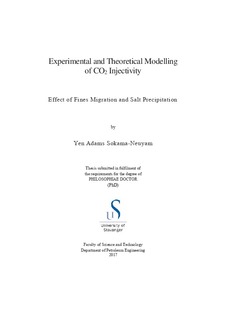| dc.contributor.advisor | Ursin, Jann Rune | |
| dc.contributor.author | Sokama-Neuyam, Yen Adams | |
| dc.date.accessioned | 2017-11-30T12:41:04Z | |
| dc.date.available | 2017-11-30T12:41:04Z | |
| dc.date.issued | 2017-11 | |
| dc.identifier.citation | Experimental and Theoretical Modelling of CO2 Injectivity : Effect of Fines Migration and Salt Precipitation by Yen Adams Sokama-Neuyam, Stavanger : University of Stavanger, 2017 (PhD thesis UiS, no. 368) | nb_NO |
| dc.identifier.isbn | 978-82-7644-740-8 | |
| dc.identifier.issn | 1890-1387 | |
| dc.identifier.uri | http://hdl.handle.net/11250/2468654 | |
| dc.description | PhD thesis in Petroleum engineering | nb_NO |
| dc.description.abstract | Adequate well injectivity is required to inject large volumes of CO2 at acceptable rates through a minimum number of wells. Mineral dissolution and salt precipitation could impair CO2 injectivity and reduce the quality and capacity of deep saline reservoirs for carbon storage. Convincing evidence of CO2 injectivity impairment induced by salt precipitation has encouraged the need to investigate other potential injectivity impairment mechanisms.
Under typical storage conditions, CO2–brine–rock reactions could generate secondary minerals in the form of fine particles into the pore fluid. Drilling fluids and cement particles may also contaminate the wellbore region. If these particles are mobilized during CO2 injection, injectivity could be severely impaired through fines entrapment. The special properties of supercritical CO2 and the high injection rates required to meet emission reduction targets, demand extension of conventional findings to understand the mechanisms of fines mobilization in relation to CO2 injection. In addition, the drying effect of upercritical CO2 makes fines mobilization and salt precipitation effects inseparable.
We investigated the impact of fines mobilization on CO2 injectivity through sandstone core-flood experiments and theoretical modelling. The impact of fines mobilization was then compared to the effects of salt precipitation. Attempt was made to investigate the coupled effect of fines mobilization and salt precipitation as the two mechanisms are inseparable under typical storage conditions. Important parameters such as CO2 injection flow rate, initial rock permeability, concentration and size of particles and saturating brine salinity were identified and studied.
We found that, mineral dissolution and fines mobilization could impose severe injectivity impairment. Up to 26 % injectivity impairment was recorded during carbonated water flooding into Berea sandstone rocks. Injectivity impairment decreased when carbonated water injection rate was increased. This implies that, under storage conditions, injectivity impairment induced by mineral dissolution and fines mobilization increases with storage time as the number of particles generated increases with CO2-brine-rock reaction rate. | nb_NO |
| dc.language.iso | eng | nb_NO |
| dc.publisher | University of Stavanger, Norway | nb_NO |
| dc.relation.ispartofseries | PhD thesis UiS; | |
| dc.relation.ispartofseries | ;368 | |
| dc.relation.haspart | Paper 1: Sokama-Neuyam Y. A., Ursin, J. R., 2017. Experimental Investigation of the Impact of Salt Precipitation on CO2 Injectivity.
Published in proceedings of International Symposium of the Society of Core Analysts, August 28 – 31, Vienna, Austria. [Not available in Brage] | |
| dc.relation.haspart | Paper 2: Sokama-Neuyam Y. A., Ursin, J. R., 2015. The Effect of Mineral Deposition on CO2 Well Injectivity. Published in proceedings of SPE EUROPEC Conference, June 1 – 4, Madrid, Spain. [Not available in Brage] | |
| dc.relation.haspart | Paper 3: Sokama-Neuyam Y. A., Ursin, J. R., 2017. Experimental and Theoretical Study of Salt Precipitation, Development of the Dry-out zone and CO2 injectivity. To be submitted for Publication. [Not available in Brage] | |
| dc.relation.haspart | Paper 4: Sokama-Neuyam Y. A., Ursin, J. R., 2015. CO2 Well Injectivity: Effect of Viscous Forces on Precipitated Minerals. Published in proceedings of International Petroleum Technology Conference, December 6 – 9, Doha, Qatar. [Not available in Brage] | |
| dc.relation.haspart | Paper 5: Sokama-Neuyam Y. A., Ursin, J. R., 2016. Experimental and Theoretical Investigations of CO2 Injectivity. AGH Drilling, Oil, Gas 33, 245 – 258. [Not available in Brage] | |
| dc.relation.haspart | Paper 6: Sokama-Neuyam Y. A., Ginting, P. U. R., Timilsina, B., Ursin, J. R., 2017. The Impact of Fines Mobilization on CO2 Injectivity: An Experimental Study. International Journal of Greenhouse Gas Control. 65, 195 – 202. | |
| dc.relation.haspart | Paper 7: Sokama-Neuyam Y. A., Forsetløkken, S. L., Lien, J., Ursin J. R., 2017. The Coupled Effect of Fines Mobilization and Salt Precipitation on CO2 Injectivity. Energies, 10(8), 1125. | |
| dc.rights | Copyright the author, all right reserved | |
| dc.rights | Navngivelse 4.0 Internasjonal | * |
| dc.rights.uri | http://creativecommons.org/licenses/by/4.0/deed.no | * |
| dc.subject | petroleumsteknologi | nb_NO |
| dc.title | Experimental and Theoretical Modelling of CO2 Injectivity : Effect of Fines Migration and Salt Precipitation | nb_NO |
| dc.type | Doctoral thesis | nb_NO |
| dc.rights.holder | © 2017 Yen Adams Sokama-Neuyam | nb_NO |
| dc.subject.nsi | VDP::Technology: 500::Rock and petroleum disciplines: 510::Petroleum engineering: 512 | nb_NO |

